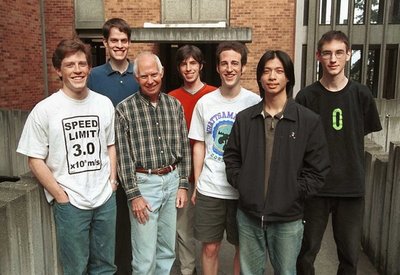April 28, 2003
Homegrown talent dominates worldwide mathematics competition
A group students in the University of Washington Department of Mathematics – all but one of them local residents and most products of public education – have taken top honors in an international mathematics competition, edging out teams from such math powerhouses as MIT, Harvard and Harvey Mudd College.
It’s just the third year that the UW has participated in the Mathematical Contest in Modeling, an annual competition administered by the Consortium for Mathematics and Its Applications, according to Jim Morrow, professor of mathematics and adviser for the teams. Last year, one of the teams – to the surprise and delight of department leaders – won big. This year, faculty members were astounded with two winners.
“I’ve been getting calls from colleagues around the country,” Morrow said. “They’re telling me ‘We’ve been doing this for almost 20 years and in just three years you’re dominating the competition.’ Needless to say, we’re very pleased with our students’ performance. We have some top-notch mathematicians.”
The winning team members are Samuel Coskey of Seattle, Mark Blunk of Issaquah, Luke Winstrom and Jeff Giansiracusa, both of Bellevue, Ernie Esser of Bothel, and Simon Pai of Taipei, Taiwan. All are seniors except for Pai, who is a sophomore.
The two teams were awarded “outstanding winner” status, a designation given to just 11 out of 638 teams from the United States and eight other countries. In addition, one UW team – Esser, Giansiracusa and Pai – received special recognition from the Mathematical Association of America, while the other team – Blunk, Coskey and Winstrom – got an award from the Institute for Operations Research and Industrial and Applied Mathematics.
“So they were the best of the best,” Morrow said, adding that this is the first time in the 19-year history of the competition that one university has had teams win for both problems that comprise the contest.
“And, with one exception, these were local students,” added Selim Tuncel, chairman of the mathematics department. “They grew up here and most went through the public education system. I think the entire area can be proud of their accomplishments.”
The contest began on Feb. 6, when officials posted two problems on the Web. The teams from the United States and eight other countries – a total of 638 participated – had until Feb. 10 to select one and devise a solution. Competitors could access sources on the Web or in the library, but could not consult with anyone outside the team. The two UW teams were operating in different rooms and had no contact with one another, so they considered the problems separately. By chance, Morrow said, each selected a different problem.
“That worked out nicely,” he said. “They weren’t competing directly against one another.”
Morrow had arranged for the students to have 24-hour computer access during the four-day window for working on the problems.
Winstrom, who competed in the contest for the first time this year, said it was much more difficult than he had imagined.
“I didn’t really take into account the quantity of sleep deprivation involved,” he said. “There were a lot of doughnuts, pop and coffee. And bizarre jokes, that got stranger as time went on and don’t make much sense now.”
The problem Winstrom’s group tackled involved designing a method of targeting a tumor in brain tissue for radiation treatment. Initially, he said, that problem seemed the harder of the two but his team picked it because the members felt it had more potential. “We had no idea how to do it when we first read it,” he said. “So we figured we’d have to come up with some really innovative ideas.”
The other problem involved a proposed movie stunt: a stuntman on a motorcycle was planning to jump an elephant, using cardboard boxes to cushion his landing. The group had to determine the size, location, configuration and number of cardboard boxes needed to do the job, taking into account different weights for the rider and motorcycle and various jump heights. But the UW group that decided to take on that scenario – Esser, Giansiracusa and Pai – quickly ran into a problem. Despite an exhaustive search, they couldn’t find good information on cardboard strength.
“So, as part of their process, they devised and conducted their own tests,” Morrow said. After launching themselves onto cardboard boxes from different angles and heights and observing what happened, the trio had data to work with. “I think the judges probably gave them points for their determination and creativity.”
All of the students are mathematics majors, although several have additional majors in related disciplines. Giansiracusa and Winstrom are also in the physics program; Coskey and Pai are studying computer science in the College of Engineering; and Esser’s other majors include Applied and Computational Mathematical Sciences and Italian.
###
For more information, contact Morrow at (206) 543-1161 or morrow@math.washington.edu, or Tuncel at (206) 543-1151 or tuncel@math.washington.edu. The students are also available for comment: Esser, Giansiracusa, Blunk and Coskey can be reached at (206) 834-0578. Pai is at (206) 634-9283 and Winstrom is at (425) 681-5908.
Information about the competition, including the problems contestants attempted to solve and overall results, can be found at http://www.comap.com/undergraduate/contests/mcm/. Information on the local teams, including .pdf files of the winning papers, is available at http://www.math.washington.edu/~morrow/mcm/mcm.html.



